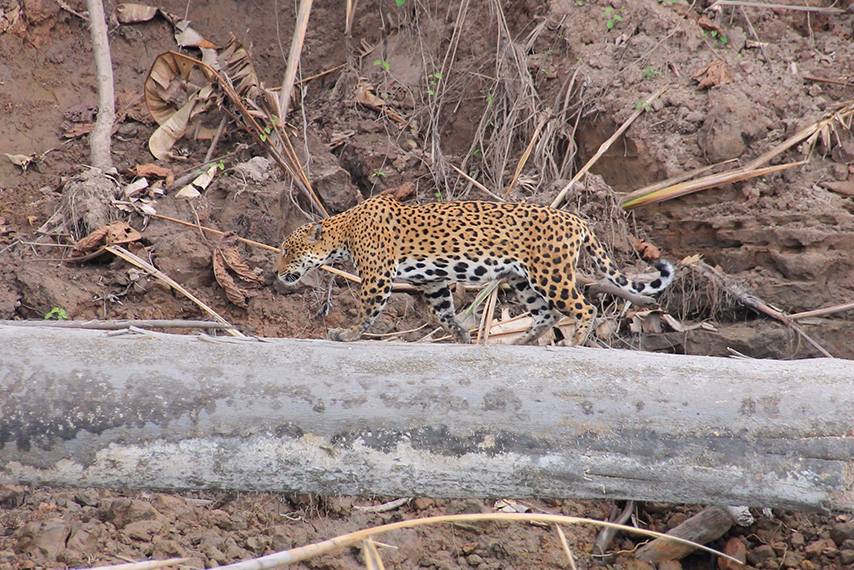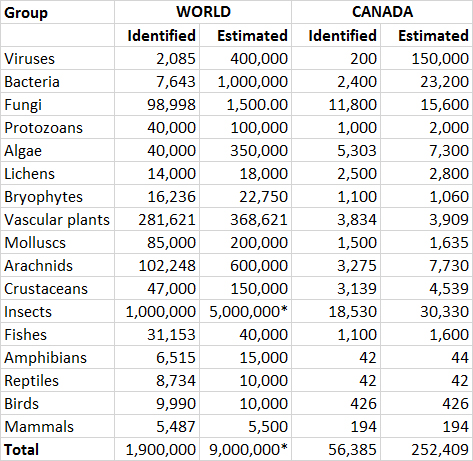Ap Environmental Science Textbook Pdf Second Edition Chapter 7 Pdf
Chapter 7 ~ Biodiversity
Key Concepts
- Outline the concept of biodiversity and explain its constituent elements.
- Explain the reasons why biodiversity is important and should be preserved.
- Define the classification of life in terms of species, genus, family, order, class, phylum, and kingdom.
- Describe the five kingdoms of life.
- genetic variation within populations and species
- numbers of species (also known as species richness)
- and the variety and dynamics of ecological communities on larger scales, such as landscapes and seascapes
Genetic Variation
Richness of Species
Richness of Communities
- Only about 0.2% of the original area of tall-grass prairie remains, the rest having been converted to agricultural use.
- Almost all of the Carolinian forest of southern Ontario has been destroyed, mostly by conversion to agricultural and urbanized landscapes.
- The survival of old-growth forest in coastal British Columbia is at risk, with the dry coastal Douglas-fir type being especially depleted. The loss of old-growth forest is mostly due to timber harvesting, which converts the ecosystem into a younger, second-growth forest (see Chapter 23).
- Throughout southern Canada, wetlands of all kinds have been destroyed or degraded by pollution, in-filling, and other disturbances.
- Natural fish populations have been widely decimated, including mixed-species communities in the Great Lakes, populations of salmonids (salmon and trout) in western Canada, and cod and redfish off the Atlantic Provinces.
- The habitats of various bottom types have been obliterated by the extensive practice of bottom-dragging in fisheries on the continental shelves, with great consequences for dependent types of ecological communities.
Utilitarian Value
- Yarrow (Achillea millefolium) is a widespread perennial herb of disturbed habitats and meadows that can be taken (often in capsule form) to treat the common cold, diarrhea, fever, and some other maladies, or used as a poultice to stanch the flow of blood from wounds. It is easily cultivated or may be gathered from the wild.
- Purple coneflower (Echinacea pallida var. angustifolia) is a perennial herb of prairie habitats that is widely drunk as a root extract. The root may also be chewed or taken in other forms to prevent or treat the common cold, sore throat, bacterial infections, and other ills. It is easily cultivated and is one of the most widely used herbal medicines in North America.
- Evening primrose (Oenothera biennis) is a widespread biennial herb of disturbed habitats and meadows that may be taken as a whole-plant infusion to treat asthma and gastrointestinal disorders, or as a pressed-oil product as a nutritional supplement. It is easily cultivated or can be gathered from the wild.
- Ginseng (Panax quinquefolius) is a perennial understorey plant of eastern hardwood forest that may be taken as a root infusion as a general tonic or to treat headache, cramps, fever, rheumatism, and other maladies. It is cultivated on a five- to seven-year rotation, and may be the most widely used herbal medicine in the world. It should not be gathered from the wild because past over-harvesting has rendered it endangered.
- Pacific yew (Taxus brevifolia) is a tree-sized plant of the humid of the west coast, and Canada yew (T. canadensis) a shrub of eastern forest. An extract of bark or leaves containing the chemical taxol has proven useful in the treatment of certain malignancies, particularly ovarian and breast cancers. Biomass for processing is gathered from wild plants, but local over-harvesting has been an issue in some areas. Plantations of Pacific yew and other yews are being established to relieve the pressure on slow-growing populations of wild plants.
- Cranberry (Vaccinium macrocarpon) is a widespread trailing shrub of bog wetlands that may be taken as a pressed juice as a source of vitamin C, to treat urinary tract infections and kidney ailments, and for other purposes for which its diuretic properties are useful. The species is extensively cultivated and is also gathered from wild habitats.
Provision of Ecological Services
Intrinsic Value
Biodiversity Is Worthwhile
Monera
Protista
Fungi
Plantae
- liverworts (division Hepaticophyta), of which there are about 6,500 species
- mosses (Bryophyta), including about 10,000 species, which are prominent in some wetlands, especially in bogs, where the dead biomass of peat mosses (species of Sphagnum) accumulates as a partially decayed material known as peat, which is mined as a soil conditioner and a source of energy
- hornworts (Anthocerophyta), with 100 species
- whisk ferns (division Psilophyta), containing several species
- club mosses and quillworts (Lycophyta), about 1,000 species
- horsetails or scouring rushes (Sphenophyta), 15 species
- ferns (Pterophyta), 12,000 species
- cycads or sago palms (Cycadophyta), 100 species
- gnetums (Gnetophyta), 70 species
- ginkgo (Ginkgophyta), with one relict species (Ginkgo biloba)
- conifers (Coniferophyta), including about 550 species of firs, hemlocks, pines, redwoods, spruces, yews, and others
- flowering plants (Anthophyta), containing a diverse assemblage of about 235,000 species
Animalia
- What are the major components of biodiversity? Provide an example of each.
- Pick any species in which you are interested. Illustrate the hierarchical classification of life by giving the scientific names of its species, genus, family, order, class, phylum, and kingdom.
- What are the five kingdoms of life? Identify several groups within each of the kingdoms.
- Why is biodiversity important? Outline several reasons.
- Discuss the notion that all species are similarly "advanced" in the evolutionary sense but may vary greatly in their complexity.
- All elements of biodiversity are considered to have intrinsic value. What does this mean? Can it be fully justified in a strictly scientific context?
- Choose an economically important "pest," such as the house mouse (Mus musculus), a disease-carrying mosquito (such as an Anopheles species), or the groups A and B Streptococcus bacteria that cause deadly infections. Now suppose that a new method has been discovered to eradicate that pest, which would cause its global extinction. Based on ideas about intrinsic value and other considerations, could you mount a logical defence of the pest to argue against its extinction?
- You are a biodiversity specialist, and a group of politicians has asked why it should spend public money to protect an endangered species occurring within their jurisdiction. You know that these people are sceptical, and that if you do not convince them to preserve the species and its habitat, it may become extinct. What information and arguments would you include in your presentation to the politicians?
- Make a comprehensive list of products of biodiversity that you use in a typical day. The list can include raw and processed foods, medicines, materials, and sources of energy.
References Cited and Further Reading
Ap Environmental Science Textbook Pdf Second Edition Chapter 7 Pdf
Source: https://ecampusontario.pressbooks.pub/environmentalscience/chapter/chapter-7-biodiversity/

